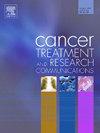成纤维细胞活化蛋白在结直肠癌中的表达及其临床应用意义
IF 2.4
Q3 Medicine
引用次数: 0
摘要
背景:结直肠癌发病率很高。间质肿瘤微环境显著影响肿瘤行为,癌症相关成纤维细胞(CAFs)作为肿瘤间质的主要组成部分,被越来越多地研究。具体来说,caf标记成纤维细胞激活蛋白(FAP)作为放射性标记FAP抑制剂(FAPI)成像的示踪剂越来越受到关注。我们描述了fap的表达模式,以及与肿瘤内基质数量的关系,建立了生物学背景和未来病理评估的潜在参考。材料和方法:收集125例ii /III期结直肠癌患者的档案组织学资料。采用血红素-伊红染色测定肿瘤-间质比(TSR),表明原发肿瘤、淋巴结和活检中间质百分比。在免疫组织化学染色中,fap的表达被半定量地评分为低表达、异质表达或中高表达。采用卡方检验评估TSR与fap表达的相关性。其他模式也被描述,例如肿瘤上皮fap表达。结果:共纳入93例患者(40例III期结肠[CC], 53例ii /III期RC)。41例(44%)间质高CRC (18/40 CC, 45%;23/53 CRC, 43%), fap高表达无统计学意义(P = 0.428 CRC;P = 0.470 cc;P = 0.615 rc)。大多数CRC有任何fap表达(78例CRC, 84%),主要是侵袭性前部,在大多数相关的LN转移中(87%的CRC肿瘤阳性LN)。然而,fap的表达往往是不均匀的,甚至可以染色健康的结肠和淋巴组织。结论:crc和LN转移瘤普遍表达FAP,但其表达水平在肿瘤间和肿瘤内差异显著,与TSR无直接相关性。在翻译FAPI-PET/CT结果时必须注意,例如疾病程度和活动,强调多学科方法的重要性。本文章由计算机程序翻译,如有差异,请以英文原文为准。
Fibroblast activation protein-expression in colorectal carcinomas and implications for clinical application
Background: Colorectal cancer is highly prevalent. The stromal tumour microenvironment significantly influences tumour behaviour, and cancer-associated fibroblasts (CAFs), as major component of tumour stroma, are increasingly studied. Specifically, CAF-marker fibroblast activation protein (FAP) is gaining interest as tracer for imaging using radiolabelled FAP-inhibitor (FAPI). We describe patterns of FAP-expression, and associations to intratumoural stroma amount, establishing a biological background and potential future reference to pathology assessment.
Materials and methods: Archival histological material from 125 stage-II/III CRC patients was collected. Haematoxylin-and-eosin staining was performed to determine the tumour-stroma ratio (TSR), indicating stromal percentages in primary tumours, lymph nodes (LNs) and biopsies. On immunohistochemistry stains, FAP-expression was semiquantitatively scored as little-no, heterogeneous, or moderate-high expression. Correlation of TSR and FAP-expression with Chi-square testing was assessed. Other patterns were also described, e.g. tumour epithelial FAP-expression.
Results: In total, 93 patients (40 stage-III colon [CC], 53 stage-II/III RC) were included. Correlation between 41 (44 %) stroma-high CRC (18/40 CC, 45 %; 23/53 RC, 43 %) with high FAP-expression was not significant (P = 0.428 CRC; P = 0.470 CC; P = 0.615 RC). The majority of CRC had any FAP-expression (78 CRC, 84 %), mostly the invasive front, and in most associated LN metastases (87 % CRC tumour-positive LN). However, FAP-expression was often heterogeneous, even staining healthy colon and lymphoid tissue.
Conclusions: CRCs and LN metastases generally express FAP, but levels vary significantly between and within tumours and have no direct correlation with TSR. Care has to be taken translating FAPI-PET/CT results with e.g. disease extent and activity, emphasizing the importance of multidisciplinary approach.
求助全文
通过发布文献求助,成功后即可免费获取论文全文。
去求助
来源期刊

Cancer treatment and research communications
Medicine-Oncology
CiteScore
4.30
自引率
0.00%
发文量
148
审稿时长
56 days
期刊介绍:
Cancer Treatment and Research Communications is an international peer-reviewed publication dedicated to providing comprehensive basic, translational, and clinical oncology research. The journal is devoted to articles on detection, diagnosis, prevention, policy, and treatment of cancer and provides a global forum for the nurturing and development of future generations of oncology scientists. Cancer Treatment and Research Communications publishes comprehensive reviews and original studies describing various aspects of basic through clinical research of all tumor types. The journal also accepts clinical studies in oncology, with an emphasis on prospective early phase clinical trials. Specific areas of interest include basic, translational, and clinical research and mechanistic approaches; cancer biology; molecular carcinogenesis; genetics and genomics; stem cell and developmental biology; immunology; molecular and cellular oncology; systems biology; drug sensitivity and resistance; gene and antisense therapy; pathology, markers, and prognostic indicators; chemoprevention strategies; multimodality therapy; cancer policy; and integration of various approaches. Our mission is to be the premier source of relevant information through promoting excellence in research and facilitating the timely translation of that science to health care and clinical practice.
 求助内容:
求助内容: 应助结果提醒方式:
应助结果提醒方式:


